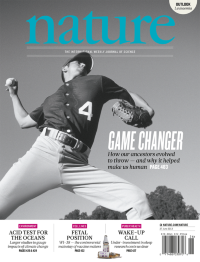Volume 498
-
No. 7455 27 June 2013
Darwin speculated that bipedalism might have contributed to humans� unique ability to throw things so well. Although some primates, including our closest relatives chimpanzees, will throw objects now and then, their throws do not come close to matching the speed and accuracy achieved by even young human boys. Neil Roach and colleagues analysed the biomechanics of collegiate baseball players� throwing motion in order to better understand the evolution of this novel behaviour. Their findings show that adaptations in the human upper body allow us to store and release elastic energy in the shoulder in a catapult-like fashion. Evidence of these key shifts in morphology that make this energy storage possible is preserved in the hominin fossil record. From these fossils, the authors infer that the ability to throw objects with high speed probably arose with Homo erectus, and may have had a crucial role in early hunting. Cover: Corbis
Nature Outlook
-
No. 7454 20 June 2013
When ice melts, the process usually starts around defects or near the surface, where the crystalline structure is relatively easily transformed into liquid water. Without such encouragement, spontaneous nucleation must take place inside homogenous bulk ice by thermal agitation, but the true mechanism of this phase transition at the molecular level is not well understood. Kenji Mochizuki and colleagues now present molecular dynamics simulations that identify the spatial separation of a defect pair into its constituent components as the crucial step. The initial formation of defect pairs occurs easily and often, but only after accidental disruption of the surrounding hydrogen-bond network and pair separation can defects persist and grow, rapidly turning ice into liquid water. Cover graphic illustrates the appearance of liquid water in the crystalline structure.
-
No. 7453 13 June 2013
The cheetah is widely recognized as the fastest animal on land, with a reported top speed of 29 metres per second. However, few precise measurements have been made and only rarely have speeds faster than racing greyhounds (18 m s−1) been recorded. Now a team from the Royal Veterinary College, UK, working with the Botswana Predator Conservation Trust, has used custom-built tracking collars containing GPS and inertial measurement units to capture the locomotor dynamics of cheetahs hunting in the wild. The top speed observed was 25.9 m s−1 (93 kilometres per hour). Most hunts involved only moderate speeds, their success relying on a combination of power, acceleration and agility. Cover: a cheetah gives chase, Serengeti National Park, Tanzania (Winfried Wisniewski/Corbis)
-
No. 7452 6 June 2013
Niels Bohr introduced what became known as the Bohr model of atomic structure in 1913. The model has since been superseded, but the familiar Solar-System-like structure was based on sound foundations and has served theorists and experiments well down the years. We mark this centenary with a special issue of Nature reflecting the past, present and future of the theory of atom structure. Cover: Thomas Porostocky




